A Hybrid Method of Analyzing Patents for Sustainable Technology Management in Humanoid Robot Industry
Abstract
:1. Introduction
2. Related Work
2.1. Cross-Impact Matrix
2.2. Topic Models
2.3. Association Rule Mining
2.4. Co-Keyword Analysis
2.5. Social Network Analysis
3. Hybrid Topic Model for Sustainable Technology Management
3.1. Sustainable Technology Management for Humanoids
3.2. Proposed Hybrid Model
4. Experimental Results and Analysis
4.1. Patent Acquisition
4.2. Pre-Processing Using Text Mining
4.3. Combined Cross-Impact Analysis
4.3.1. Sub-Technology Extraction Using Topic Model (LDA)
4.3.2. Keywords Extraction of Each Patent Using TF-IDF
4.3.3. Matching Patents with Sub-Technologies
4.3.4. Generating Cross-Impact Matrix
4.4. Combined Cross-Impact Analysis
4.4.1. Drawing Weighted Network Graph for Core Cross-Impact Matrix
4.4.2. Drawing Bipartite Network Graph for Applicant-Sub-Technology Matrix
5. Conclusions
Acknowledgments
Author Contributions
Conflicts of Interest
References
- Ting, C.H.; Yeo, W.H.; King, Y.J.; Chuah, Y.D.; Lee, J.V.; Khaw, W.B. Humanoid robot: A review of the architecture, applications and future trend. Res. J. Appl. Sci. Eng. Technol. 2014, 7, 1364–1369. [Google Scholar]
- You, B.J.; Oh, Y.H.; Choi, Y.J. Survey on humanoid researches. J. Korean Soc. Precision Eng. 2004, 21, 15–21. (In Korean) [Google Scholar]
- Lin, P.; Abney, K.; Bekey, G.A. Robot Ethics: The Ethical and Social Implications of Robotics; The MIT Press: Massachusetts, USA, 2012. [Google Scholar]
- Lee, S.; Kang, S.; Park, Y.S.; Park, Y. Technology roadmapping for R & D planning: The case of the Korean parts and material industry. Technovation 2007, 27, 433–445. [Google Scholar]
- Arora, A.; Gambardella, A. The market for technology. Handb. Econ. Innov. 2011, 1, 641–678. [Google Scholar]
- Gordon, T.J. Cross-impact matrices: An illustration of their use for policy analysis. Futures 1969, 1, 527–531. [Google Scholar] [CrossRef]
- Gordon, T.J.; Hayward, H. Initial experiments with the cross impact matrix method of forecasting. Futures 1968, 1, 100–116. [Google Scholar] [CrossRef]
- Mishra, S.; Deshmukh, S.G.; Vrat, P. Matching of technological forecasting technique to a technology. Technol. Forecast. Soc. Change 2002, 69, 1–27. [Google Scholar] [CrossRef]
- KIPRIS. Korea Intellectual Property Rights Information Service. Available online: http://www.kipris.or.kr (accessed on 10 May 2016).
- Korea Intellectual Property Office. Patent and Information Analysis (for Researchers); Gyungsung Book: Seoul, Korea, 2009. (In Korean) [Google Scholar]
- Tseng, Y.H.; Lin, C.J.; Lin, Y.I. Text mining technique for patent analysis. Inf. Processing Manage. 2007, 43, 1216–1247. [Google Scholar] [CrossRef]
- Fattori, M.; Pedrazzi, G.; Turra, R. Text mining applied to patent mapping: A practical business case. World Patent Inf. 2003, 25, 335–342. [Google Scholar] [CrossRef]
- Yoon, B.; Park, Y. A systematic approach for identifying technology opportunities: Keyword-based morphology analysis. Technol. Forecast. Soc. Change 2005, 72, 145–160. [Google Scholar] [CrossRef]
- Lee, S.; Yoon, B.; Park, Y. An approach to discovering new technology opportunities: Keyword-based patent map approach. Technovation 2009, 29, 481–497. [Google Scholar] [CrossRef]
- Jeong, G.H.; Kim, S.H. A qualitative cross-impact approach to find the key technology. Technol. Forecast. Soc. Change 1997, 55, 203–214. [Google Scholar] [CrossRef]
- Choi, C.; Kim, S.; Park, Y. A patent-based cross impact analysis for quantitative estimation of technological impact: The case of information and communication technology. Technol. Forecast. Soc. Change 2007, 74, 1296–1314. [Google Scholar] [CrossRef]
- Thorleuchter, D.; Van den Poel, D.; Prinzie, A. A compared R & D-based and patent-based cross impact analysis for identifying relationships between technologies. Technol. Forecast. Soc. Change 2010, 77, 1037–1050. [Google Scholar]
- Blei, D.M. Probabilistic topic models. Commun. ACM 2012, 55, 77–84. [Google Scholar] [CrossRef]
- Zhang, Y.; Zhang, G.; Chen, H.; Porter, A.L.; Zhu, D.; Lu, J. Topic analysis and forecasting for science, technology and innovation: Methodology with a case study focusing on big data research. Technol. Forecast. Soc. Change 2016, 105, 179–191. [Google Scholar] [CrossRef]
- Kotsiantis, S.; Kanellopoulos, D. Association rules mining: A recent overview. Int. Trans. Comput. Sci. Eng. 2006, 32, 71–82. [Google Scholar]
- Shih, M.J.; Liu, D.R.; Hsu, M.L. Mining change in patent trends for competitive intelligence. In Advances in Knowledge Discovery and Data Mining; Washio, T., Suzuki, E., Ting, K.M., Inokuchi, A., Eds.; Springer: Berlin, Germany, 2000; Volume 5012, pp. 999–1005. [Google Scholar]
- Kim, C.; Lee, H.; Seol, H.; Lee, C. Identifying core technologies based on technological cross-impacts: An association rule mining (ARM) and analytic network process (ANP) approach. Expert Syst. Appl. 2011, 38, 12559–12564. [Google Scholar] [CrossRef]
- Lee, B.; Jeong, Y.I. Mapping Korea’s national R & D domain of robot technology by using the co-word analysis. Scientometrics 2008, 77, 3–19. [Google Scholar]
- Rip, A.; Courtial, J. Co-word maps of biotechnology: An example of cognitive scientometrics. Scientometrics 1984, 6, 381–400. [Google Scholar] [CrossRef]
- Otte, E.; Rousseau, R. Social network analysis: A powerful strategy, also for the information sciences. J. Inf. Sci. 2002, 28, 441–453. [Google Scholar] [CrossRef]
- Yoon, J.; Choi, S.; Kim, K. Invention property-function network analysis of patents: A case of silicon-based thin film solar cells. Scientometrics 2010, 86, 687–703. [Google Scholar] [CrossRef]
- Silver, D.; Huang, A.; Maddison, C.J.; Guez, A.; Sifre, L.; van den Driessche, G.; Schrittwieser, J.; Antonoglou, I.; Panneershelvam, V.; Lanctot, M.; et al. Mastering the game of Go with deep neural networks and tree search. Nature 2016, 529, 484–489. [Google Scholar] [CrossRef] [PubMed]
- One Hundred Year Study on Artificial Intelligence (AI100). Available online: http://ai100.stanford.edu/ (accessed on 10 May 2016).
- Choi, J.; Jang, D.; Jun, S.; Park, S. A predictive model of technology transfer using patent analysis. Sustainability 2015, 7, 16175–16195. [Google Scholar] [CrossRef]
- Kim, S.; Jang, D.; Jun, S.; Park, S. A novel forecasting methodology for sustainable management of defense technology. Sustainability 2015, 7, 16720–16736. [Google Scholar] [CrossRef]
- Rousseeuw, P.J. Silhouettes: A graphical aid to the interpretation and validation of cluster analysis. J. Comput. Appl. Math. 1987, 20, 53–65. [Google Scholar] [CrossRef]
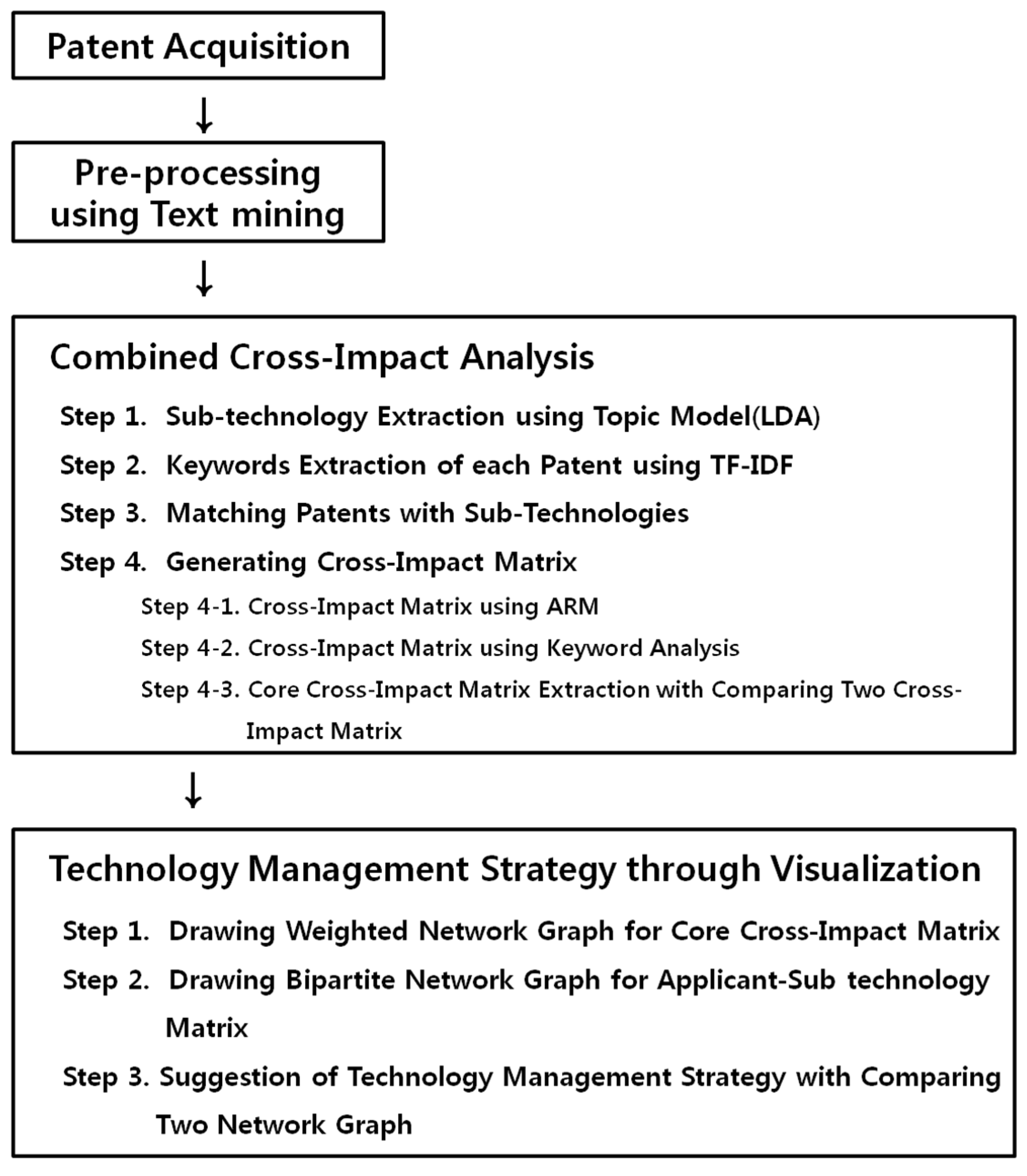
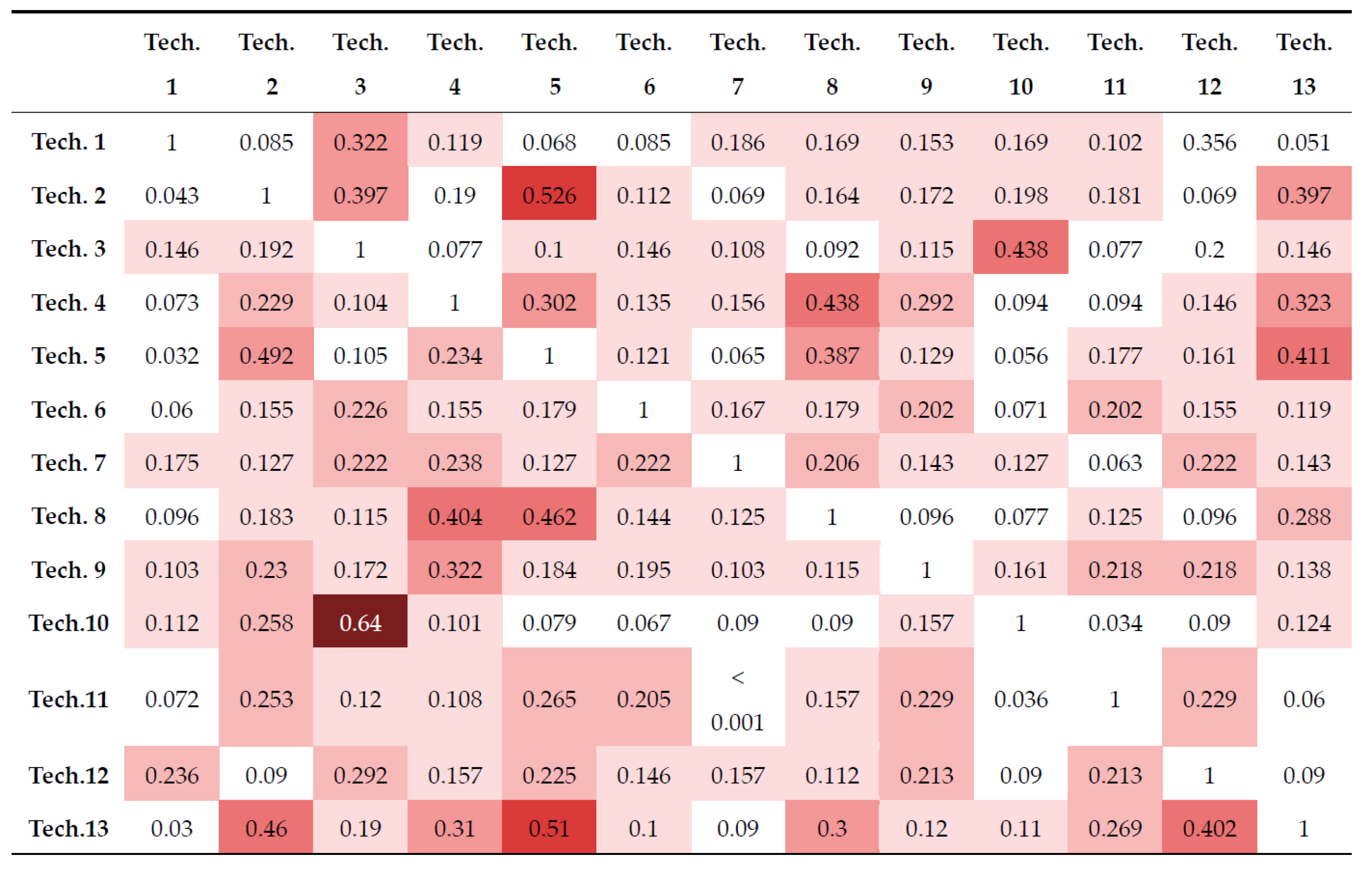
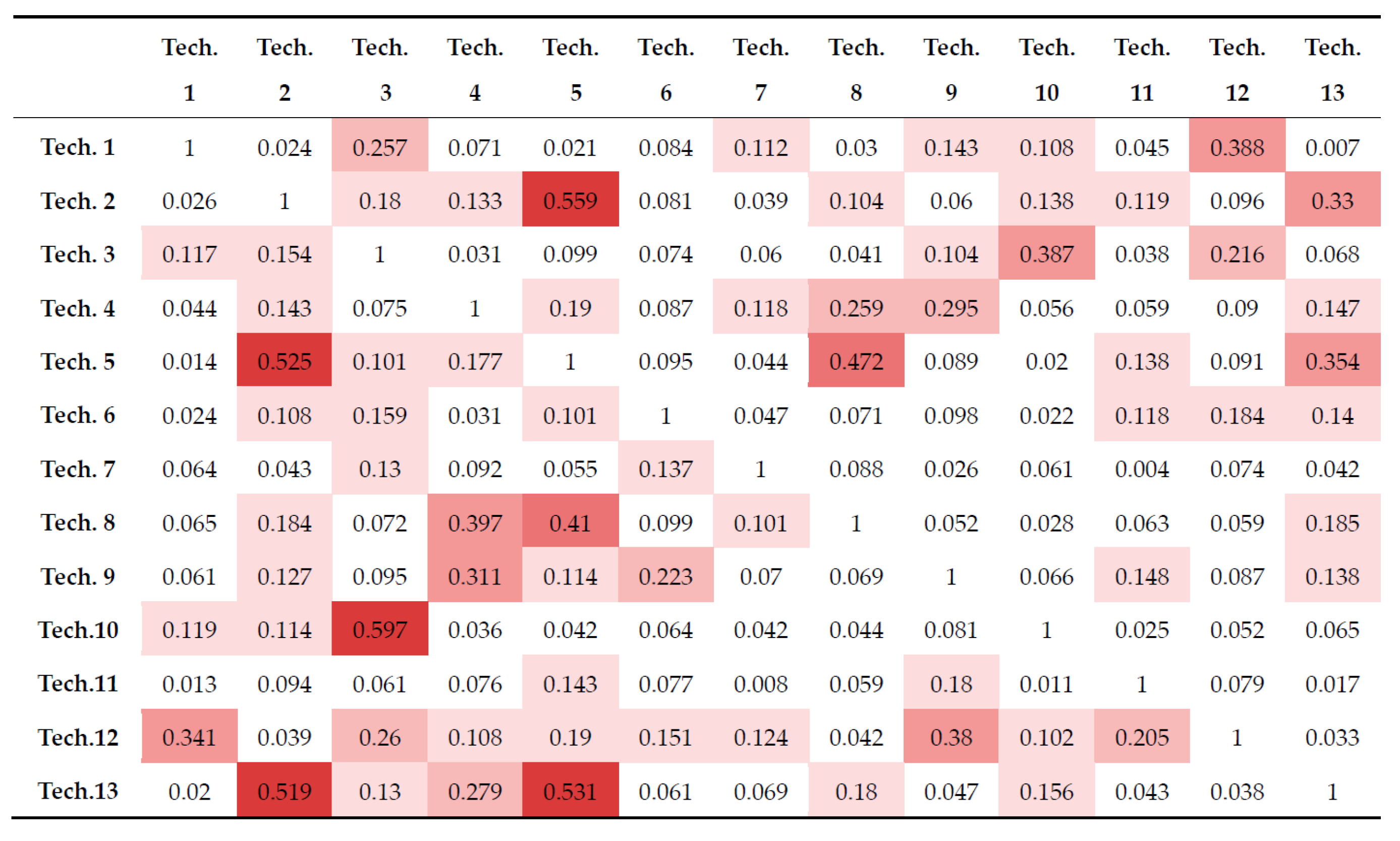
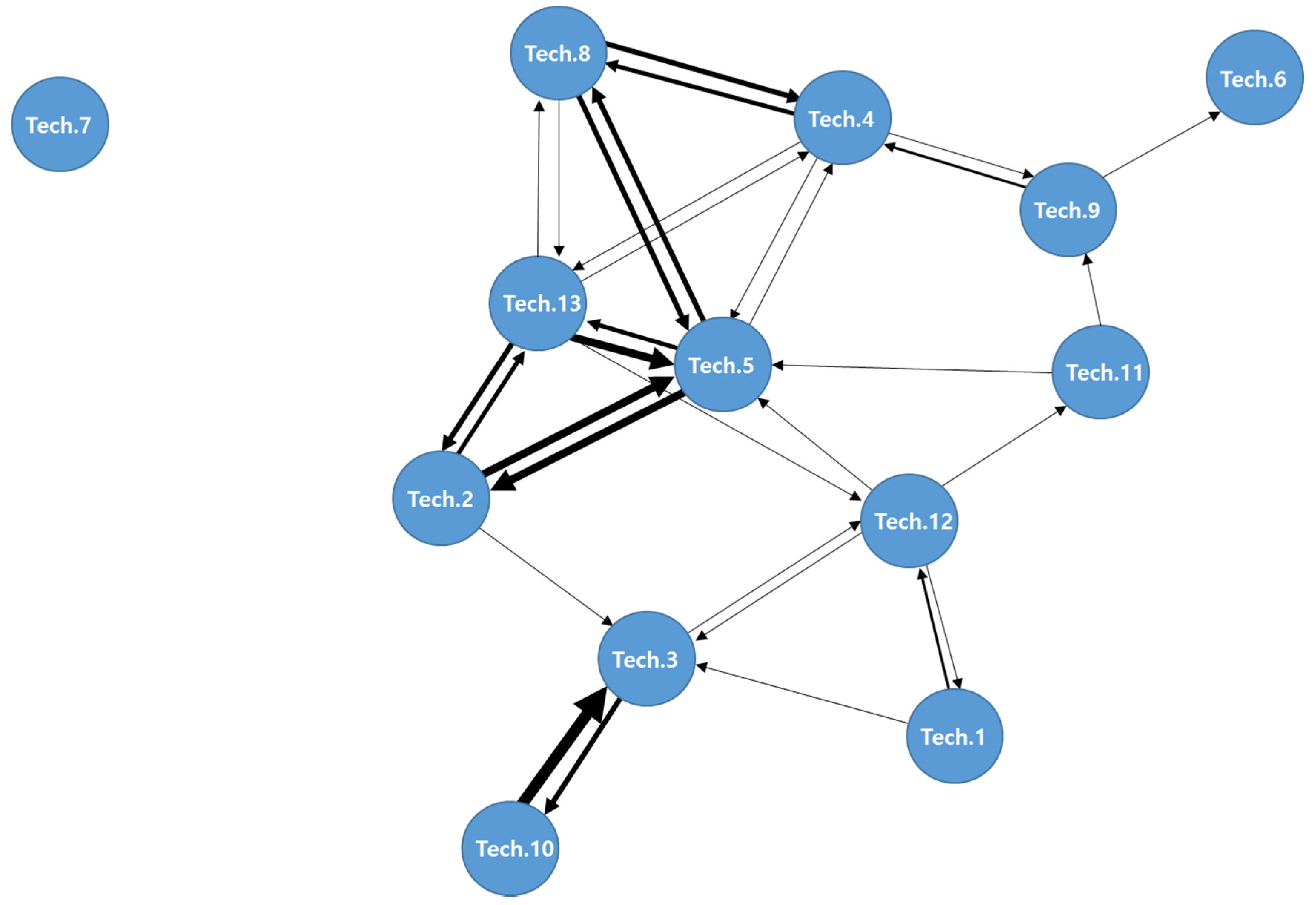
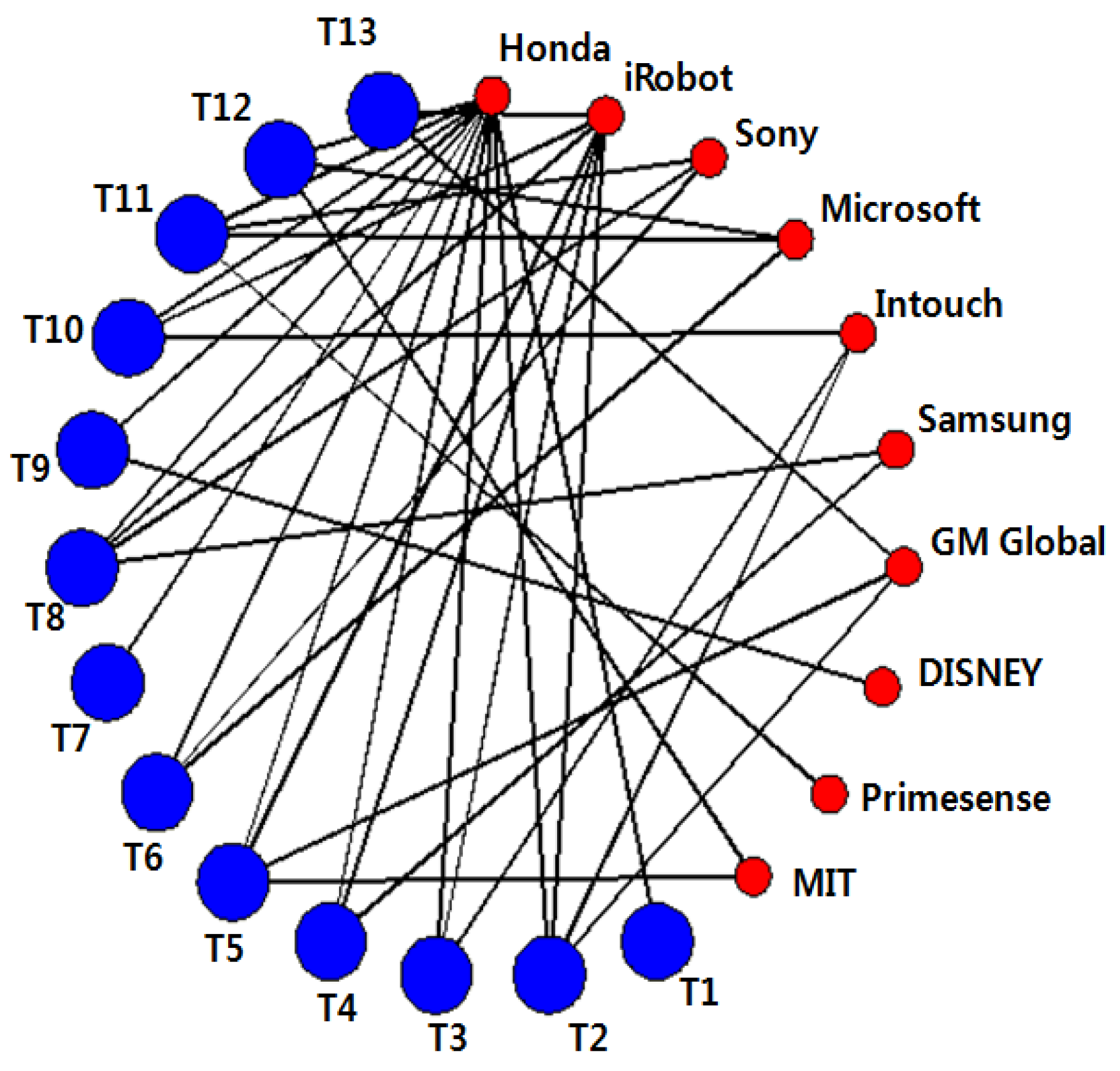
| Database | Keyword | Period | Nation | Patents | Noise Data | Valid Data |
|---|---|---|---|---|---|---|
| Wips | Humanoid | –Dec. 27th, 2015 | US | 1000 | 99 | 901 |
| X = 4 | X = 5 | X = 6 | X = 7 | X = 8 | X = 9 | X = 10 | X = 11 | X = 12 | X = 13 |
| 0.03 | 0.04 | 0.05 | 0.06 | 0.07 | 0.07 | 0.08 | 0.08 | 0.09 | 0.094 |
| X = 14 | X = 15 | X = 16 | X = 17 | X = 18 | X = 19 | X = 20 | X = 21 | X = 22 | X = 23 |
| −0.003 | 0.005 | 0.01 | 0.016 | 0.0215 | 0.026 | 0.034 | 0.038 | −0.052 | −0.048 |
| X = 24 | X = 25 | X = 26 | X = 27 | X = 28 | X = 29 | X = 30 | X = 31 | X = 32 | X = 33 |
| −0.043 | −0.039 | −0.35 | −0.03 | −0.025 | −0.02 | −0.015 | −0.011 | −0.007 | −0.003 |
| X = 34 | X = 35 | X = 36 | X = 37 | X = 38 | X = 39 | X = 40 | X = 41 | X = 42 | X = 43 |
| 0.001 | 0.004 | 0.008 | 0.0127 | 0.0169 | 0.0206 | 0.0225 | 0.0267 | 0.0298 | 0.0233 |
| Topic | Keywords | Technology |
|---|---|---|
| 1 | Messag, sender, voic, multimedia, surgic, microphone, document, invas, text, entity, audio, emoticon, invari, entity, instrument | Communication System |
| 2 | Platform, fall, articul, assemble, shoulder, phantom, dphm, widget, organ, tendon, heterogen, traction, depthbas, anthropomorph, centermass | Robot Joint |
| 3 | Station, section, speech, event, nois, line, convers, water, quiet, acoust, status, face, overhead, session, genom | Remote Station |
| 4 | Member, ball, guid, finger, bin, terrain, cooper, panorama, popul, cohort, bar, puzzl, counterbalance, cross, performed | Robot Finger |
| 5 | Assembl, wheel, acceler, spring, rotary, vehicle, imped, gripper, air, flexion, transmitt, articular, candi, lingual, plantar | Robotic Vehicle |
| 6 | Trunk, knowledge, touchscreen, hiup game, test, crane, neck, salienc, driver, item, loop, class, figurin, cord | Knowledge-based Robot |
| 7 | Emot, attent, tactil, easi, tag, physiology, scanner, array, illus, good, transit, stimulus, frequenc, marker, nervous | Tactile Sensor |
| 8 | Softwar, layer, hal, hardwar, finger, seat, media, grip, rnn, beam, vehicle, wheel, emphas, context, passing | Hardware Abstraction Layer |
| 9 | Pose, energy, key, exoskeleton, nonhumanoid, beat, music, slide, pipe, guid, cuff, telescop, teach, metal, descriptor | Energy Management and Sound System |
| 10 | Patient, station, batteri, gateway, breast, framework, bound, beacon plate, charg, engine, status, bridg, bright, acquisit | Patient Rounding System |
| 11 | Depth, target, zmp, gait, ann, question, shell, rout, bone, appendage, isol, grasp, bag, geography, cloud | Depth Map and Gait System |
| 12 | Anim, path, node, entity, file, face, extens, mesh, flexion, soft, creation, tissue, graph, share, brake | Path Planning System |
| 13 | Clean, fluid, subsystem, debri, avatar, assembl, world, zone, term, cash, channel, core, roller, avatars, floorclean | Cleaning Robot System |
| Patents | Tech. 1 | Tech. 2 | … | Tech. 13 |
|---|---|---|---|---|
| 1 | 0 | 1 | … | 1 |
| 2 | 0 | 1 | … | 0 |
| ︙ | ︙ | ︙ | ︙ | ︙ |
| 776 | 0 | 0 | … | 0 |
| Tech. 1 | Tech. 2 | Tech. 3 | Tech. 4 | Tech. 5 | Tech. 6 | Tech. 7 | Tech. 8 | Tech. 9 | Tech. 10 | Tech. 11 | Tech. 12 | Tech. 13 | |
|---|---|---|---|---|---|---|---|---|---|---|---|---|---|
| Tech. 1 | 6.605 | 0.099 | 1.025 | 0.321 | 0.086 | 0.272 | 0.383 | 0.148 | 0.605 | 0.506 | 0.198 | 2.012 | 0.049 |
| Tech. 2 | 0.17 | 4.106 | 0.716 | 0.596 | 2.305 | 0.262 | 0.135 | 0.511 | 0.255 | 0.645 | 0.525 | 0.497 | 2.234 |
| Tech. 3 | 0.773 | 0.633 | 3.987 | 0.14 | 0.407 | 0.24 | 0.207 | 0.2 | 0.44 | 1.807 | 0.167 | 1.12 | 0.46 |
| Tech. 4 | 0.288 | 0.586 | 0.297 | 4.496 | 0.784 | 0.279 | 0.405 | 1.27 | 1.243 | 0.261 | 0.261 | 0.469 | 0.991 |
| Tech. 5 | 0.095 | 2.157 | 0.401 | 0.796 | 4.122 | 0.306 | 0.15 | 2.32 | 0.374 | 0.095 | 0.605 | 0.469 | 2.395 |
| Tech. 6 | 0.16 | 0.443 | 0.632 | 0.142 | 0.415 | 3.226 | 0.16 | 0.349 | 0.415 | 0.104 | 0.519 | 0.953 | 0.943 |
| Tech. 7 | 0.422 | 0.177 | 0.52 | 0.412 | 0.226 | 0.441 | 3.422 | 0.43 | 0.108 | 0.284 | 0.019 | 0.382 | 0.284 |
| Tech. 8 | 0.426 | 0.754 | 0.287 | 1.787 | 1.689 | 0.32 | 0.344 | 4.91 | 0.221 | 0.131 | 0.279 | 0.303 | 1.254 |
| Tech. 9 | 0.4 | 0.52 | 0.38 | 1.4 | 0.47 | 0.72 | 0.24 | 0.34 | 4.22 | 0.31 | 0.65 | 0.45 | 0.93 |
| Tech. 10 | 0.784 | 0.469 | 2.378 | 0.162 | 0.171 | 0.207 | 0.144 | 0.216 | 0.342 | 4.667 | 0.108 | 0.27 | 0.441 |
| Tech. 11 | 0.085 | 0.386 | 0.242 | 0.34 | 0.588 | 0.248 | 0.026 | 0.288 | 0.758 | 0.052 | 4.392 | 0.412 | 0.118 |
| Tech. 12 | 2.252 | 0.162 | 1.036 | 0.487 | 0.784 | 0.487 | 0.423 | 0.207 | 1.604 | 0.478 | 0.901 | 5.18 | 0.225 |
| Tech. 13 | 0.131 | 2.131 | 0.516 | 1.254 | 2.189 | 0.197 | 0.238 | 0.885 | 0.197 | 0.73 | 0.189 | 0.197 | 6.762 |
| Tech. 1 | Tech. 2 | Tech. 3 | Tech. 4 | Tech. 5 | Tech. 6 | Tech. 7 | Tech. 8 | Tech. 9 | Tech. 10 | Tech. 11 | Tech. 12 | Tech. 13 | |
|---|---|---|---|---|---|---|---|---|---|---|---|---|---|
| Tech. 1 | 1 | 0 | 0.29 | 0 | 0 | 0 | 0 | 0 | 0 | 0 | 0 | 0.372 | 0 |
| Tech. 2 | 0 | 1 | 0.289 | 0 | 0.543 | 0 | 0 | 0 | 0 | 0 | 0 | 0 | 0.364 |
| Tech. 3 | 0 | 0 | 1 | 0 | 0 | 0 | 0 | 0 | 0 | 0.413 | 0 | 0.208 | 0 |
| Tech. 4 | 0 | 0 | 0 | 1 | 0.246 | 0 | 0 | 0.349 | 0.294 | 0 | 0 | 0 | 0.235 |
| Tech. 5 | 0 | 0.509 | 0 | 0.206 | 1 | 0 | 0 | 0.43 | 0 | 0 | 0 | 0 | 0.383 |
| Tech. 6 | 0 | 0 | 0 | 0 | 0 | 1 | 0 | 0 | 0 | 0 | 0 | 0 | 0 |
| Tech. 7 | 0 | 0 | 0 | 0 | 0 | 0 | 1 | 0 | 0 | 0 | 0 | 0 | 0 |
| Tech. 8 | 0 | 0 | 0 | 0.401 | 0.436 | 0 | 0 | 1 | 0 | 0 | 0 | 0 | 0.237 |
| Tech. 9 | 0 | 0 | 0 | 0.317 | 0 | 0.209 | 0 | 0 | 1 | 0 | 0 | 0 | 0 |
| Tech. 10 | 0 | 0 | 0.619 | 0 | 0 | 0 | 0 | 0 | 0 | 1 | 0 | 0 | 0 |
| Tech. 11 | 0 | 0 | 0 | 0 | 0.204 | 0 | 0 | 0 | 0.205 | 0 | 1 | 0 | 0 |
| Tech. 12 | 0.289 | 0 | 0.276 | 0 | 0.208 | 0 | 0 | 0 | 0.297 | 0 | 0.209 | 1 | 0 |
| Tech. 13 | 0 | 0.49 | 0 | 0.295 | 0.521 | 0 | 0 | 0.24 | 0 | 0 | 0 | 0.22 | 1 |
| Ranking | Company | Patents |
|---|---|---|
| 1 | Honda Research Institute Europe GmbH | 100 |
| 2 | iRobot Corporation | 77 |
| 3 | Sony Corporation | 48 |
| 4 | Microsoft Corporation | 41 |
| 5 | InTouch Technologies, Inc. | 39 |
| 6 | Samsung Electronics | 26 |
| 7 | GM Global Technology Operations, Inc. | 20 |
| 8 | Disney Enterprises, INC., A Delaware Corporation | 19 |
| 9 | Primesense Ltd. | 17 |
| 10 | Massachusetts Institute of Technology | 16 |
| T1 | T2 | T3 | T4 | T5 | T6 | T7 | T8 | T9 | T10 | T11 | T12 | T13 | |
|---|---|---|---|---|---|---|---|---|---|---|---|---|---|
| Honda | 17 | 23 | 30 | 15 | 13 | 11 | 10 | 17 | 15 | 13 | 36 | 10 | 0 |
| iRobot | 0 | 14 | 19 | 10 | 34 | 0 | 0 | 29 | 0 | 25 | 0 | 0 | 117 |
| Sony | 0 | 0 | 0 | 0 | 0 | 18 | 0 | 17 | 0 | 0 | 16 | 0 | 0 |
| Microsoft | 0 | 0 | 0 | 0 | 0 | 14 | 0 | 0 | 0 | 0 | 32 | 11 | 0 |
| Intouch | 0 | 14 | 38 | 0 | 0 | 0 | 0 | 0 | 0 | 44 | 0 | 0 | 0 |
| Samsung | 0 | 0 | 0 | 25 | 0 | 0 | 0 | 11 | 0 | 0 | 0 | 0 | 0 |
| GM | 0 | 17 | 0 | 0 | 21 | 0 | 0 | 0 | 0 | 0 | 0 | 0 | 13 |
| Disney | 0 | 0 | 0 | 0 | 0 | 0 | 0 | 0 | 21 | 0 | 0 | 0 | 0 |
| Primesense | 0 | 0 | 0 | 0 | 0 | 0 | 0 | 0 | 0 | 0 | 17 | 0 | 0 |
| MIT | 0 | 0 | 0 | 0 | 25 | 0 | 0 | 0 | 0 | 0 | 0 | 10 | 0 |
© 2016 by the authors; licensee MDPI, Basel, Switzerland. This article is an open access article distributed under the terms and conditions of the Creative Commons Attribution (CC-BY) license (http://creativecommons.org/licenses/by/4.0/).
Share and Cite
Kim, J.; Lee, J.; Kim, G.; Park, S.; Jang, D. A Hybrid Method of Analyzing Patents for Sustainable Technology Management in Humanoid Robot Industry. Sustainability 2016, 8, 474. https://doi.org/10.3390/su8050474
Kim J, Lee J, Kim G, Park S, Jang D. A Hybrid Method of Analyzing Patents for Sustainable Technology Management in Humanoid Robot Industry. Sustainability. 2016; 8(5):474. https://doi.org/10.3390/su8050474
Chicago/Turabian StyleKim, Jongchan, Joonhyuck Lee, Gabjo Kim, Sangsung Park, and Dongsik Jang. 2016. "A Hybrid Method of Analyzing Patents for Sustainable Technology Management in Humanoid Robot Industry" Sustainability 8, no. 5: 474. https://doi.org/10.3390/su8050474
APA StyleKim, J., Lee, J., Kim, G., Park, S., & Jang, D. (2016). A Hybrid Method of Analyzing Patents for Sustainable Technology Management in Humanoid Robot Industry. Sustainability, 8(5), 474. https://doi.org/10.3390/su8050474





